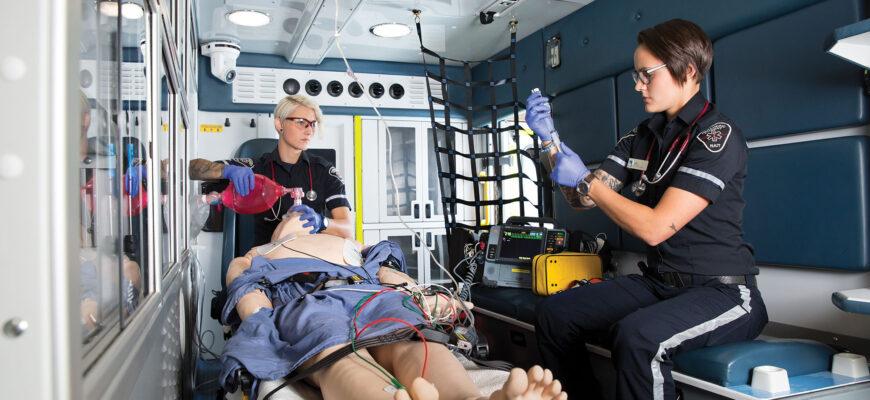Emergency Medical Technicians undergo several levels of training which provide a great and clear idea of how your career as an EMT might progress over the years. The great news is that with each higher level you achieve your earnings potential also increases. This is particularly important considering that the cost of training courses drastically increases as you move up the levels.
Normally people assume that everyone working inside an ambulance is a paramedic. But the fact is, there are four different levels of Emergency Medical Services (EMS) professionals who work alternatively in an ambulance, each with a different scope of services they have been trained to provide.
So what are the different levels of EMT Pretty much all states distinguish between 3 levels of EMT: EMT-Basic (EMT-B), EMT-Intermediate (EMT-I), and EMT-Paramedic (EMT-P). While all states simply refer to EMT Basic and EMT Paramedic, a lot of states use different description for EMT Intermediate, which we will get to shortly
EMT-Basic or EMT
This is the level that you will start at when you first start your career as an EMT. At this level you will be trained in the basic procedures of patient care, and a basic level of illness and injury diagnosis and first treatment. The main focus for an EMT-B is fast and basic on the scene treatment and transport to a hospital or other medical provider.
An EMT’s scope of practice includes basic, non-invasive interventions to reduce the morbidity and mortality associated with acute out-of-hospital medical and traumatic emergencies. EMTs can also provide care to minimize secondary injury and provide comfort to the patient and family while transporting the patient to an emergency care facility.
In most states basic training is conducted over a 6 to15 week period and consists of a minimum of 120 hours of classroom training and clinical placement.
The things you will be qualified to perform are set by your state’s Emergency Medical Services Agency. Generally speaking an EMT-B is qualified and licensed to perform basic assessment and non-invasive treatment but to give you an idea here are a few things:
- Cardiopulmonary resuscitation (CPR)
- Automated External Defibrillation (AED)
- mechanical ventilation using bag-valve mask
- pulse oximetry
- glucometer
- splinting of limbs and spinal immobilization
Steps to become a EMT or EMT-B
- Complete a state-approved EMT course -Different states have different requirements, but an EMT program typically requires 3–11 weeks or about 120 hours of instruction. Candidates must have completed the course within the past two years.
- Hold a current CPR-BLS for “Healthcare Provider” or equivalent credential.
- Pass Examination
- cognitive exam- You will take the National Registry Medical Technician (EMT) cognitive exam on a computer at an authorized testing center. Your exam will consist of between 70 and 120 questions. 10 of those questions will not affect your score. The maximum time to complete the exam is 2 hours.
- Psychomotor exam– The National Registry does not administer the EMT psychomotor exams. All EMT psychomotor exams are administered by either the State EMS Office or at the training institution.
EMT-intermediate or AEMT
This is a level that has many different references throughout the USA. Some states have two levels of EMT-I, some states are phasing out EMT-I and other states refer to it simply as Advanced EMT. To avoid any confusion here, we will simply refer to EMT-I, but you should check our state specific information by clicking on the map on the home page.
EMT-intermediate are qualified and authorized to provide the same services as an EMT and administer fluids and some medications, and use the advanced medical equipment carried in the ambulance. EMT-intermediate also provides care to minimize secondary injury and provide comfort to the patient and family while transporting the patient to an emergency care facility.
This level is achieved through a combination of intermediate level training and passing of related exams.
Just like the EMT-B level, the procedures allowed to be performed by and EMT-I differ by state, but generally speaking they would include all the above listed treatments and may include the following:
- basic airway management
- administration of intravenous non-medical fluids like saline
- administration of epinephrine (with limits on the concentration)
- administration of medications such as glucagons, naloxone, albuterol and nitrous oxide
Steps to become a EMT-Intermediate
- Hold current certification or state license at the EMT level or higher.
- Complete a state-approved Advanced EMT course– Different states have different requirements, but an AEMT or EMT-I program typically requires the EMT program PLUS an additional 350 hours of instruction. Candidates must have completed the course within the past two years.
- Hold a current CPR-BLS for “Healthcare Provider” or equivalent credential.
- Pass Examination
Cognitive Exam
You will take the National Registry Medical Technician (AEMT) cognitive exam on a computer at an authorized testing center. Your exam will consist of 135 questions. 35 of those questions will not affect your score. The maximum time to complete the exam is 2 hours and 15 minutes.
Psychomotor exam
The EMT-I psychomotor examination consists of 10 skills presented in a scenario-type format. Advanced EMTs are required to demonstrate proficiency in the areas like Trauma, Ventilatory Management, Cardiac Arrest Management etc.
EMT-Paramedic or Paramedic
This is the highest level of Emergency Medical Technician and is achieved after extensive training and examination usually over an 18 to 24 months period. In some states you will be awarded with a degree upon passing your exams, which is a fantastic achievement to aim for.
The paramedic provides care designed to minimize secondary injury and provide comfort to the patient and family while transporting the patient to an appropriate health care facility.A paramedic has the knowledge associated with the EMT-basic and EMT-intermediate.
The major difference between the EMT-paramedic and the EMT-intermediate is the ability to perform a broader range of advanced skills. The scope of practice is limited to advanced skills that are effective and can be performed safely in an out-of-hospital setting with medical oversight.
Just like with the other two levels of EMT each state dictates what a Paramedic is allowed to perform as part of patient assessment and treatment. Paramedics usually work closely with EMTs of different levels as well as with other Emergency Services in order to assure the best possible patient care.
Some of the additional responsibilities and procedures may include:
- spinal and fracture injury management in the field
- assistance in childbirth
- advanced airways management including surgical
- administration of medicines including narcotic pain relief, sedatives, antipsychotics and cardiac medication
As you can see, the procedures a Paramedic is trained to perform are quite extensive, which explains the reason for the years of training required.
Steps to becoming a paramedic
Following are the steps to become a paramedic-
- Hold current National Registry Certification or state license at the EMT level or higher.
- Complete a CAAHEP-accredited paramedic education program-Paramedic certification courses focus on the more advanced practice of medicine, like pharmacology, cardiology, and anatomy. To graduate from paramedic school, you must complete an internship working in a hospital or ambulance.
- Hold a current CPR-BLS for “Healthcare Provider” or equivalent credential.
- Pass Examinations
- Cognitive exam
Your exam will consist of between 80 questions to 150 questions. Each exam will have between 60 to 130 “live” items that count toward the final score. The maximum amount of time to complete the exam is 2 hours and 30 minutes.
-
- Psychomotor exam
The Paramedic psychomotor exam tests candidates on the skills like patient assessment, dynamic cardiology, static cardiology, oral station case A etc..






